Human Rights and Civil Liberties: Racism, Culture, and Identities
VerifiedAdded on 2022/08/26
|16
|3847
|13
Essay
AI Summary
This essay addresses key concepts in human rights and civil liberties, drawing on a case study of the Sami people's land dispute in Sweden. The first section theoretically describes the formation and utilization of stereotypes, referencing social identity theory and real-world examples. The second section differentiates between racial and cultural differences, highlighting their distinct characteristics. Finally, the essay examines how different forms of ascribed identities intersect within the context of the Sami land dispute, applying Grosfoguel, Oso, and Christou's understanding of intersectionality to analyze the complex interplay of oppression and privilege. The essay aims to provide a comprehensive understanding of these interconnected issues and their impact on marginalized groups.
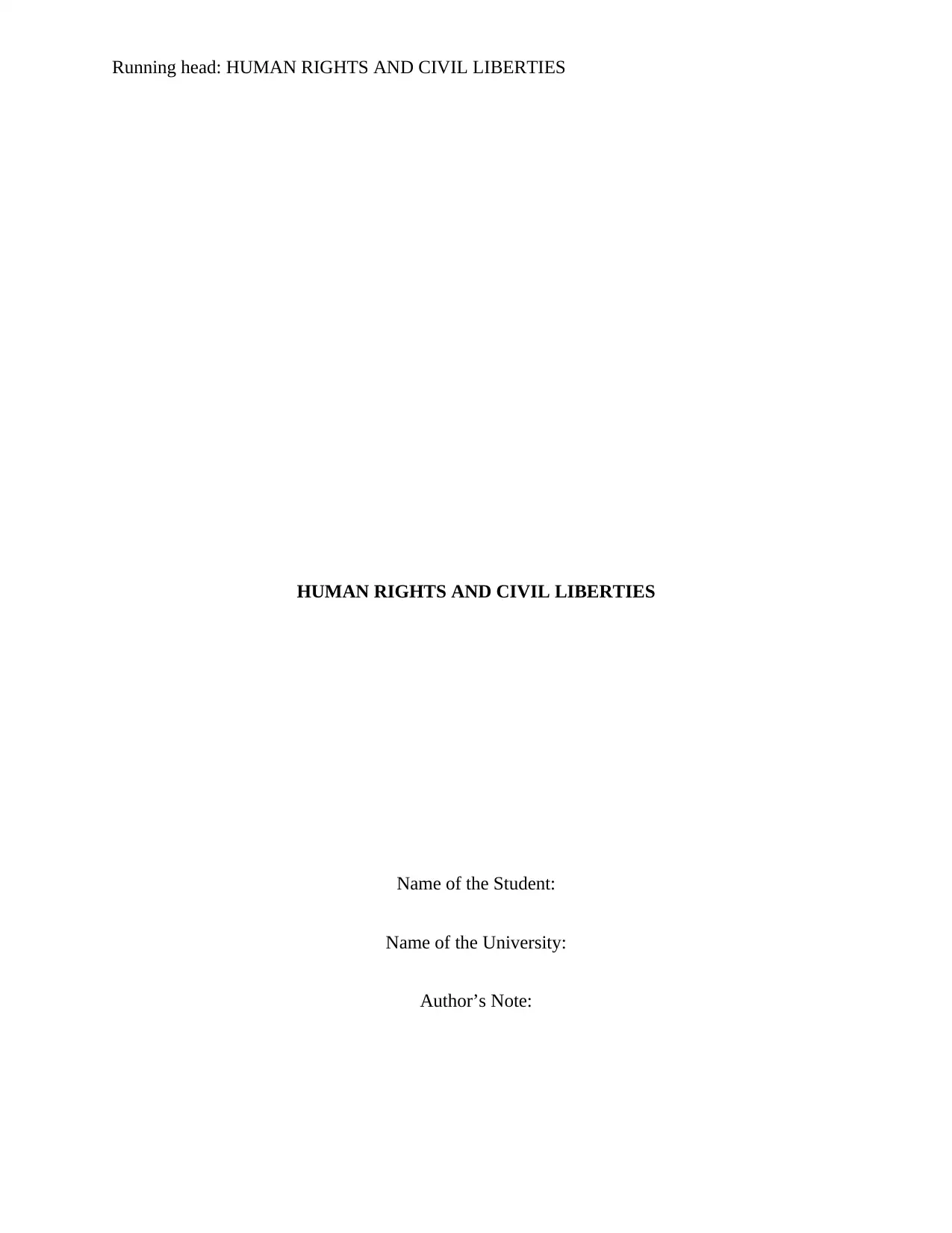
Running head: HUMAN RIGHTS AND CIVIL LIBERTIES
HUMAN RIGHTS AND CIVIL LIBERTIES
Name of the Student:
Name of the University:
Author’s Note:
HUMAN RIGHTS AND CIVIL LIBERTIES
Name of the Student:
Name of the University:
Author’s Note:
Paraphrase This Document
Need a fresh take? Get an instant paraphrase of this document with our AI Paraphraser
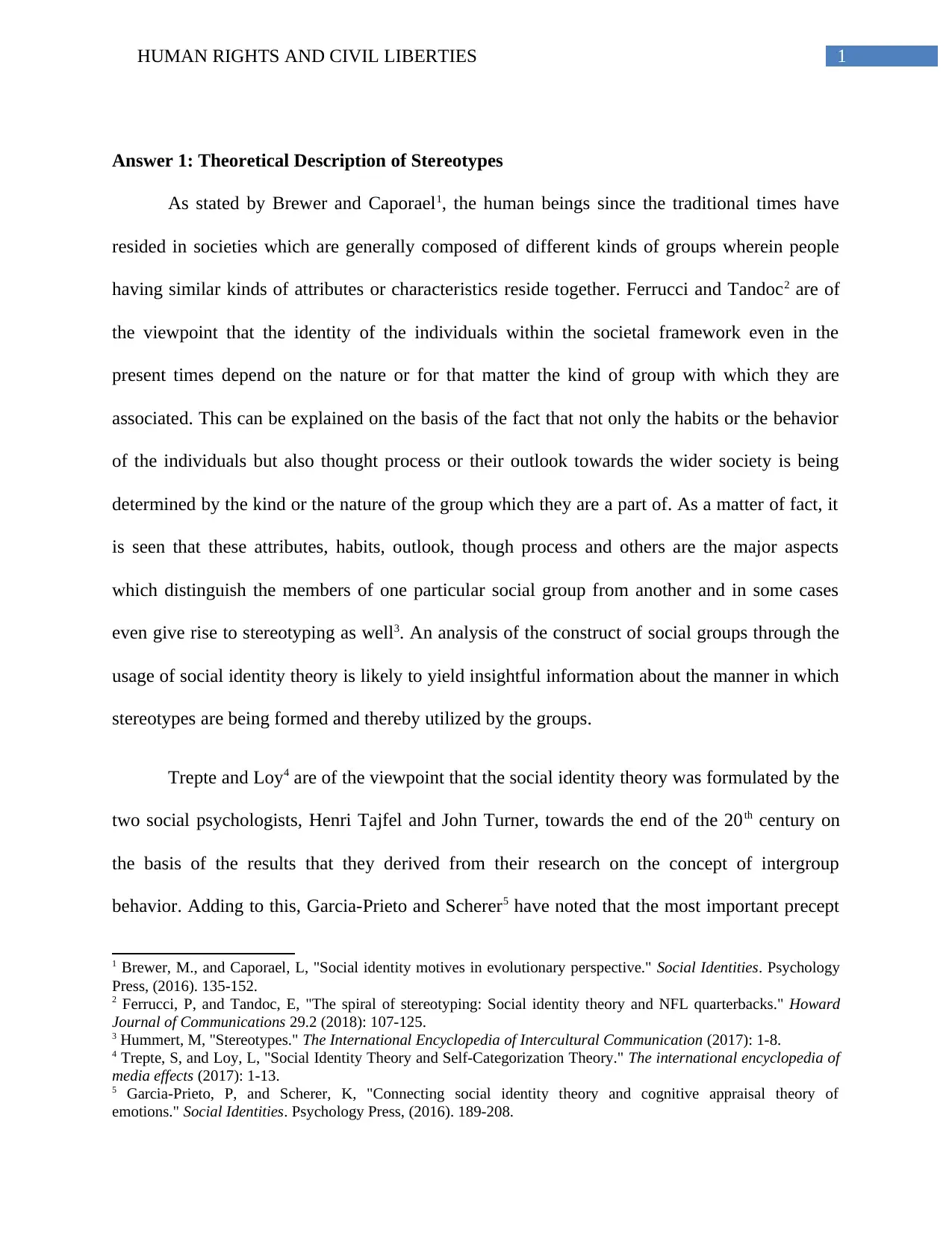
1HUMAN RIGHTS AND CIVIL LIBERTIES
Answer 1: Theoretical Description of Stereotypes
As stated by Brewer and Caporael1, the human beings since the traditional times have
resided in societies which are generally composed of different kinds of groups wherein people
having similar kinds of attributes or characteristics reside together. Ferrucci and Tandoc2 are of
the viewpoint that the identity of the individuals within the societal framework even in the
present times depend on the nature or for that matter the kind of group with which they are
associated. This can be explained on the basis of the fact that not only the habits or the behavior
of the individuals but also thought process or their outlook towards the wider society is being
determined by the kind or the nature of the group which they are a part of. As a matter of fact, it
is seen that these attributes, habits, outlook, though process and others are the major aspects
which distinguish the members of one particular social group from another and in some cases
even give rise to stereotyping as well3. An analysis of the construct of social groups through the
usage of social identity theory is likely to yield insightful information about the manner in which
stereotypes are being formed and thereby utilized by the groups.
Trepte and Loy4 are of the viewpoint that the social identity theory was formulated by the
two social psychologists, Henri Tajfel and John Turner, towards the end of the 20th century on
the basis of the results that they derived from their research on the concept of intergroup
behavior. Adding to this, Garcia-Prieto and Scherer5 have noted that the most important precept
1 Brewer, M., and Caporael, L, "Social identity motives in evolutionary perspective." Social Identities. Psychology
Press, (2016). 135-152.
2 Ferrucci, P, and Tandoc, E, "The spiral of stereotyping: Social identity theory and NFL quarterbacks." Howard
Journal of Communications 29.2 (2018): 107-125.
3 Hummert, M, "Stereotypes." The International Encyclopedia of Intercultural Communication (2017): 1-8.
4 Trepte, S, and Loy, L, "Social Identity Theory and Self‐Categorization Theory." The international encyclopedia of
media effects (2017): 1-13.
5 Garcia-Prieto, P, and Scherer, K, "Connecting social identity theory and cognitive appraisal theory of
emotions." Social Identities. Psychology Press, (2016). 189-208.
Answer 1: Theoretical Description of Stereotypes
As stated by Brewer and Caporael1, the human beings since the traditional times have
resided in societies which are generally composed of different kinds of groups wherein people
having similar kinds of attributes or characteristics reside together. Ferrucci and Tandoc2 are of
the viewpoint that the identity of the individuals within the societal framework even in the
present times depend on the nature or for that matter the kind of group with which they are
associated. This can be explained on the basis of the fact that not only the habits or the behavior
of the individuals but also thought process or their outlook towards the wider society is being
determined by the kind or the nature of the group which they are a part of. As a matter of fact, it
is seen that these attributes, habits, outlook, though process and others are the major aspects
which distinguish the members of one particular social group from another and in some cases
even give rise to stereotyping as well3. An analysis of the construct of social groups through the
usage of social identity theory is likely to yield insightful information about the manner in which
stereotypes are being formed and thereby utilized by the groups.
Trepte and Loy4 are of the viewpoint that the social identity theory was formulated by the
two social psychologists, Henri Tajfel and John Turner, towards the end of the 20th century on
the basis of the results that they derived from their research on the concept of intergroup
behavior. Adding to this, Garcia-Prieto and Scherer5 have noted that the most important precept
1 Brewer, M., and Caporael, L, "Social identity motives in evolutionary perspective." Social Identities. Psychology
Press, (2016). 135-152.
2 Ferrucci, P, and Tandoc, E, "The spiral of stereotyping: Social identity theory and NFL quarterbacks." Howard
Journal of Communications 29.2 (2018): 107-125.
3 Hummert, M, "Stereotypes." The International Encyclopedia of Intercultural Communication (2017): 1-8.
4 Trepte, S, and Loy, L, "Social Identity Theory and Self‐Categorization Theory." The international encyclopedia of
media effects (2017): 1-13.
5 Garcia-Prieto, P, and Scherer, K, "Connecting social identity theory and cognitive appraisal theory of
emotions." Social Identities. Psychology Press, (2016). 189-208.
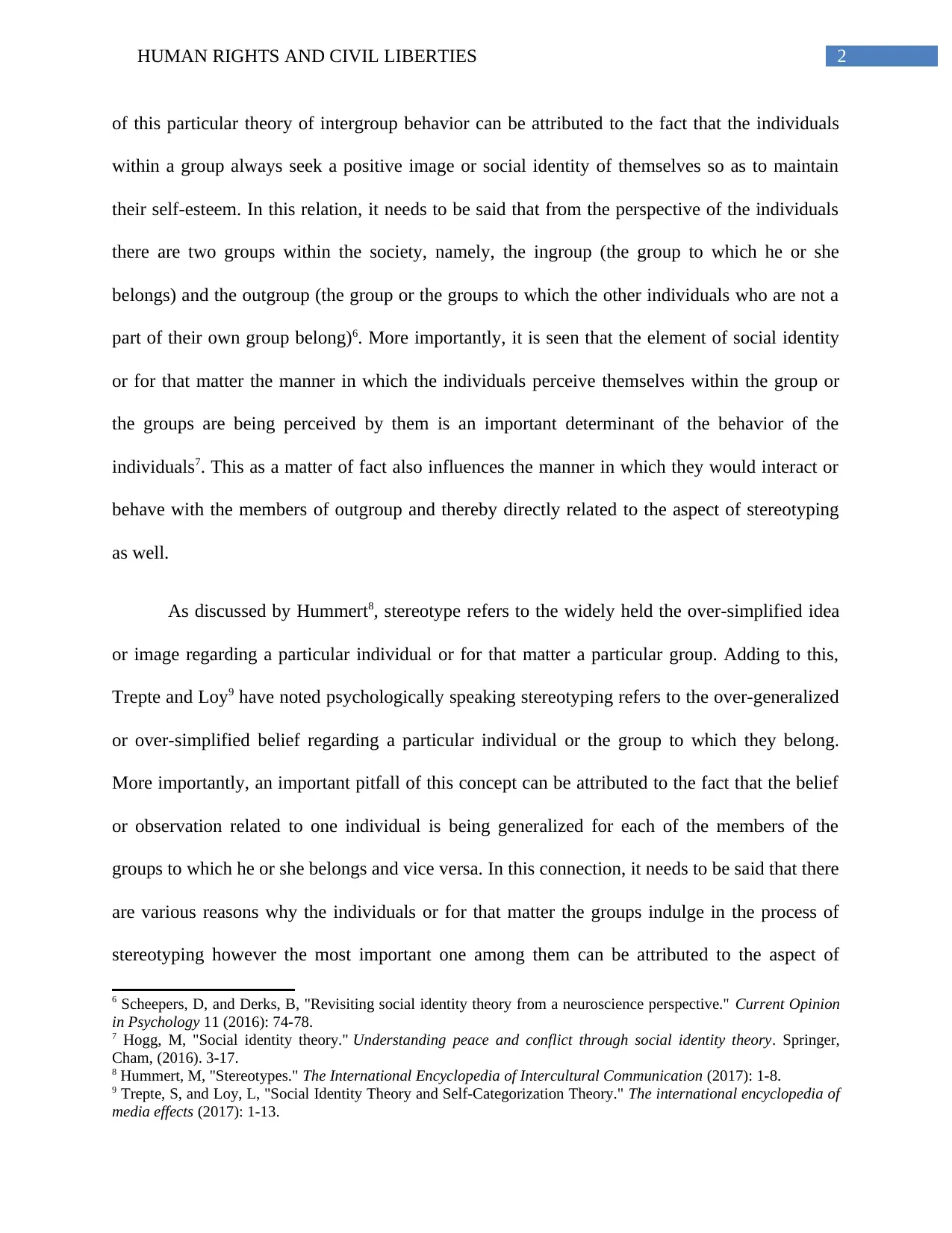
2HUMAN RIGHTS AND CIVIL LIBERTIES
of this particular theory of intergroup behavior can be attributed to the fact that the individuals
within a group always seek a positive image or social identity of themselves so as to maintain
their self-esteem. In this relation, it needs to be said that from the perspective of the individuals
there are two groups within the society, namely, the ingroup (the group to which he or she
belongs) and the outgroup (the group or the groups to which the other individuals who are not a
part of their own group belong)6. More importantly, it is seen that the element of social identity
or for that matter the manner in which the individuals perceive themselves within the group or
the groups are being perceived by them is an important determinant of the behavior of the
individuals7. This as a matter of fact also influences the manner in which they would interact or
behave with the members of outgroup and thereby directly related to the aspect of stereotyping
as well.
As discussed by Hummert8, stereotype refers to the widely held the over-simplified idea
or image regarding a particular individual or for that matter a particular group. Adding to this,
Trepte and Loy9 have noted psychologically speaking stereotyping refers to the over-generalized
or over-simplified belief regarding a particular individual or the group to which they belong.
More importantly, an important pitfall of this concept can be attributed to the fact that the belief
or observation related to one individual is being generalized for each of the members of the
groups to which he or she belongs and vice versa. In this connection, it needs to be said that there
are various reasons why the individuals or for that matter the groups indulge in the process of
stereotyping however the most important one among them can be attributed to the aspect of
6 Scheepers, D, and Derks, B, "Revisiting social identity theory from a neuroscience perspective." Current Opinion
in Psychology 11 (2016): 74-78.
7 Hogg, M, "Social identity theory." Understanding peace and conflict through social identity theory. Springer,
Cham, (2016). 3-17.
8 Hummert, M, "Stereotypes." The International Encyclopedia of Intercultural Communication (2017): 1-8.
9 Trepte, S, and Loy, L, "Social Identity Theory and Self‐Categorization Theory." The international encyclopedia of
media effects (2017): 1-13.
of this particular theory of intergroup behavior can be attributed to the fact that the individuals
within a group always seek a positive image or social identity of themselves so as to maintain
their self-esteem. In this relation, it needs to be said that from the perspective of the individuals
there are two groups within the society, namely, the ingroup (the group to which he or she
belongs) and the outgroup (the group or the groups to which the other individuals who are not a
part of their own group belong)6. More importantly, it is seen that the element of social identity
or for that matter the manner in which the individuals perceive themselves within the group or
the groups are being perceived by them is an important determinant of the behavior of the
individuals7. This as a matter of fact also influences the manner in which they would interact or
behave with the members of outgroup and thereby directly related to the aspect of stereotyping
as well.
As discussed by Hummert8, stereotype refers to the widely held the over-simplified idea
or image regarding a particular individual or for that matter a particular group. Adding to this,
Trepte and Loy9 have noted psychologically speaking stereotyping refers to the over-generalized
or over-simplified belief regarding a particular individual or the group to which they belong.
More importantly, an important pitfall of this concept can be attributed to the fact that the belief
or observation related to one individual is being generalized for each of the members of the
groups to which he or she belongs and vice versa. In this connection, it needs to be said that there
are various reasons why the individuals or for that matter the groups indulge in the process of
stereotyping however the most important one among them can be attributed to the aspect of
6 Scheepers, D, and Derks, B, "Revisiting social identity theory from a neuroscience perspective." Current Opinion
in Psychology 11 (2016): 74-78.
7 Hogg, M, "Social identity theory." Understanding peace and conflict through social identity theory. Springer,
Cham, (2016). 3-17.
8 Hummert, M, "Stereotypes." The International Encyclopedia of Intercultural Communication (2017): 1-8.
9 Trepte, S, and Loy, L, "Social Identity Theory and Self‐Categorization Theory." The international encyclopedia of
media effects (2017): 1-13.
⊘ This is a preview!⊘
Do you want full access?
Subscribe today to unlock all pages.

Trusted by 1+ million students worldwide
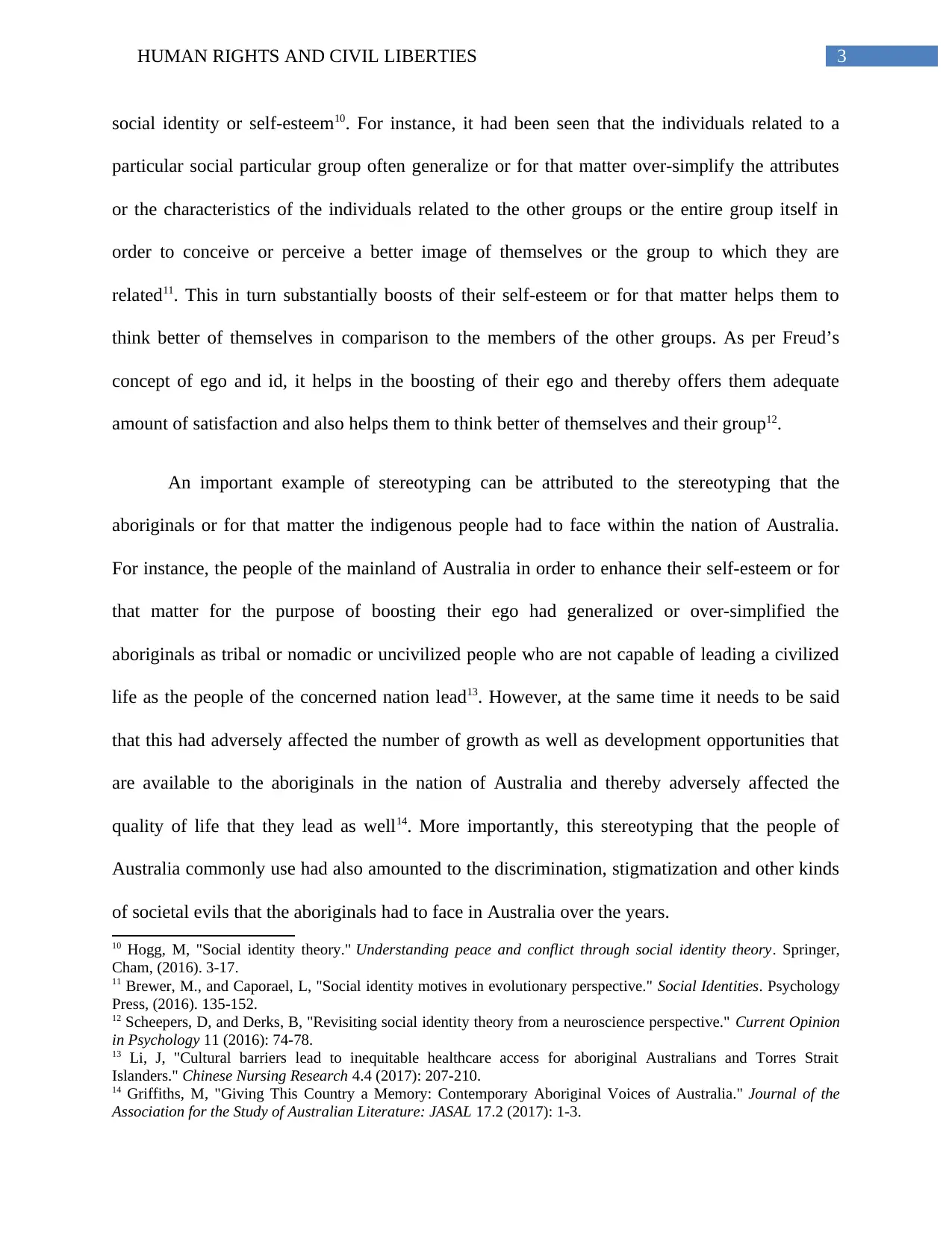
3HUMAN RIGHTS AND CIVIL LIBERTIES
social identity or self-esteem10. For instance, it had been seen that the individuals related to a
particular social particular group often generalize or for that matter over-simplify the attributes
or the characteristics of the individuals related to the other groups or the entire group itself in
order to conceive or perceive a better image of themselves or the group to which they are
related11. This in turn substantially boosts of their self-esteem or for that matter helps them to
think better of themselves in comparison to the members of the other groups. As per Freud’s
concept of ego and id, it helps in the boosting of their ego and thereby offers them adequate
amount of satisfaction and also helps them to think better of themselves and their group12.
An important example of stereotyping can be attributed to the stereotyping that the
aboriginals or for that matter the indigenous people had to face within the nation of Australia.
For instance, the people of the mainland of Australia in order to enhance their self-esteem or for
that matter for the purpose of boosting their ego had generalized or over-simplified the
aboriginals as tribal or nomadic or uncivilized people who are not capable of leading a civilized
life as the people of the concerned nation lead13. However, at the same time it needs to be said
that this had adversely affected the number of growth as well as development opportunities that
are available to the aboriginals in the nation of Australia and thereby adversely affected the
quality of life that they lead as well14. More importantly, this stereotyping that the people of
Australia commonly use had also amounted to the discrimination, stigmatization and other kinds
of societal evils that the aboriginals had to face in Australia over the years.
10 Hogg, M, "Social identity theory." Understanding peace and conflict through social identity theory. Springer,
Cham, (2016). 3-17.
11 Brewer, M., and Caporael, L, "Social identity motives in evolutionary perspective." Social Identities. Psychology
Press, (2016). 135-152.
12 Scheepers, D, and Derks, B, "Revisiting social identity theory from a neuroscience perspective." Current Opinion
in Psychology 11 (2016): 74-78.
13 Li, J, "Cultural barriers lead to inequitable healthcare access for aboriginal Australians and Torres Strait
Islanders." Chinese Nursing Research 4.4 (2017): 207-210.
14 Griffiths, M, "Giving This Country a Memory: Contemporary Aboriginal Voices of Australia." Journal of the
Association for the Study of Australian Literature: JASAL 17.2 (2017): 1-3.
social identity or self-esteem10. For instance, it had been seen that the individuals related to a
particular social particular group often generalize or for that matter over-simplify the attributes
or the characteristics of the individuals related to the other groups or the entire group itself in
order to conceive or perceive a better image of themselves or the group to which they are
related11. This in turn substantially boosts of their self-esteem or for that matter helps them to
think better of themselves in comparison to the members of the other groups. As per Freud’s
concept of ego and id, it helps in the boosting of their ego and thereby offers them adequate
amount of satisfaction and also helps them to think better of themselves and their group12.
An important example of stereotyping can be attributed to the stereotyping that the
aboriginals or for that matter the indigenous people had to face within the nation of Australia.
For instance, the people of the mainland of Australia in order to enhance their self-esteem or for
that matter for the purpose of boosting their ego had generalized or over-simplified the
aboriginals as tribal or nomadic or uncivilized people who are not capable of leading a civilized
life as the people of the concerned nation lead13. However, at the same time it needs to be said
that this had adversely affected the number of growth as well as development opportunities that
are available to the aboriginals in the nation of Australia and thereby adversely affected the
quality of life that they lead as well14. More importantly, this stereotyping that the people of
Australia commonly use had also amounted to the discrimination, stigmatization and other kinds
of societal evils that the aboriginals had to face in Australia over the years.
10 Hogg, M, "Social identity theory." Understanding peace and conflict through social identity theory. Springer,
Cham, (2016). 3-17.
11 Brewer, M., and Caporael, L, "Social identity motives in evolutionary perspective." Social Identities. Psychology
Press, (2016). 135-152.
12 Scheepers, D, and Derks, B, "Revisiting social identity theory from a neuroscience perspective." Current Opinion
in Psychology 11 (2016): 74-78.
13 Li, J, "Cultural barriers lead to inequitable healthcare access for aboriginal Australians and Torres Strait
Islanders." Chinese Nursing Research 4.4 (2017): 207-210.
14 Griffiths, M, "Giving This Country a Memory: Contemporary Aboriginal Voices of Australia." Journal of the
Association for the Study of Australian Literature: JASAL 17.2 (2017): 1-3.
Paraphrase This Document
Need a fresh take? Get an instant paraphrase of this document with our AI Paraphraser
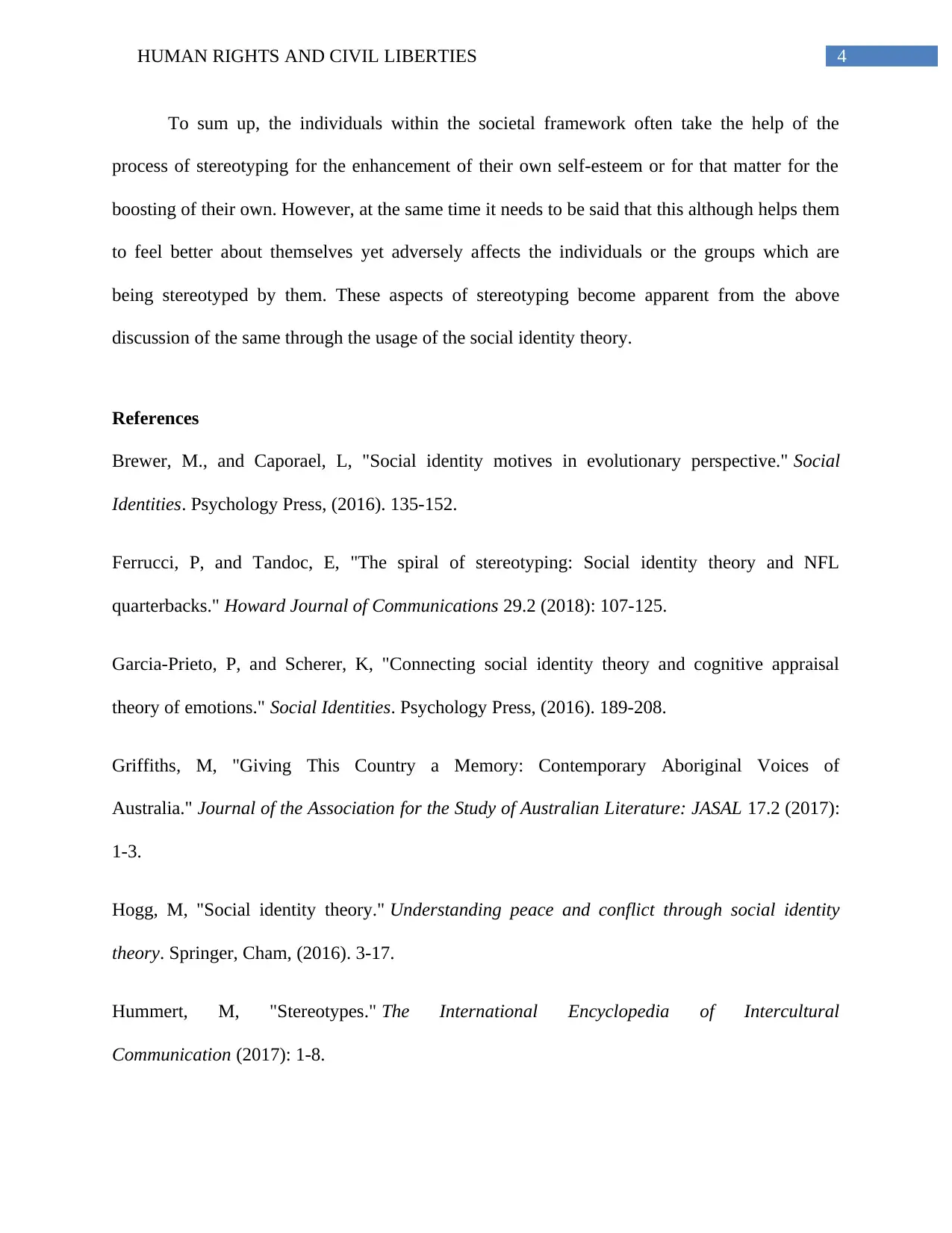
4HUMAN RIGHTS AND CIVIL LIBERTIES
To sum up, the individuals within the societal framework often take the help of the
process of stereotyping for the enhancement of their own self-esteem or for that matter for the
boosting of their own. However, at the same time it needs to be said that this although helps them
to feel better about themselves yet adversely affects the individuals or the groups which are
being stereotyped by them. These aspects of stereotyping become apparent from the above
discussion of the same through the usage of the social identity theory.
References
Brewer, M., and Caporael, L, "Social identity motives in evolutionary perspective." Social
Identities. Psychology Press, (2016). 135-152.
Ferrucci, P, and Tandoc, E, "The spiral of stereotyping: Social identity theory and NFL
quarterbacks." Howard Journal of Communications 29.2 (2018): 107-125.
Garcia-Prieto, P, and Scherer, K, "Connecting social identity theory and cognitive appraisal
theory of emotions." Social Identities. Psychology Press, (2016). 189-208.
Griffiths, M, "Giving This Country a Memory: Contemporary Aboriginal Voices of
Australia." Journal of the Association for the Study of Australian Literature: JASAL 17.2 (2017):
1-3.
Hogg, M, "Social identity theory." Understanding peace and conflict through social identity
theory. Springer, Cham, (2016). 3-17.
Hummert, M, "Stereotypes." The International Encyclopedia of Intercultural
Communication (2017): 1-8.
To sum up, the individuals within the societal framework often take the help of the
process of stereotyping for the enhancement of their own self-esteem or for that matter for the
boosting of their own. However, at the same time it needs to be said that this although helps them
to feel better about themselves yet adversely affects the individuals or the groups which are
being stereotyped by them. These aspects of stereotyping become apparent from the above
discussion of the same through the usage of the social identity theory.
References
Brewer, M., and Caporael, L, "Social identity motives in evolutionary perspective." Social
Identities. Psychology Press, (2016). 135-152.
Ferrucci, P, and Tandoc, E, "The spiral of stereotyping: Social identity theory and NFL
quarterbacks." Howard Journal of Communications 29.2 (2018): 107-125.
Garcia-Prieto, P, and Scherer, K, "Connecting social identity theory and cognitive appraisal
theory of emotions." Social Identities. Psychology Press, (2016). 189-208.
Griffiths, M, "Giving This Country a Memory: Contemporary Aboriginal Voices of
Australia." Journal of the Association for the Study of Australian Literature: JASAL 17.2 (2017):
1-3.
Hogg, M, "Social identity theory." Understanding peace and conflict through social identity
theory. Springer, Cham, (2016). 3-17.
Hummert, M, "Stereotypes." The International Encyclopedia of Intercultural
Communication (2017): 1-8.
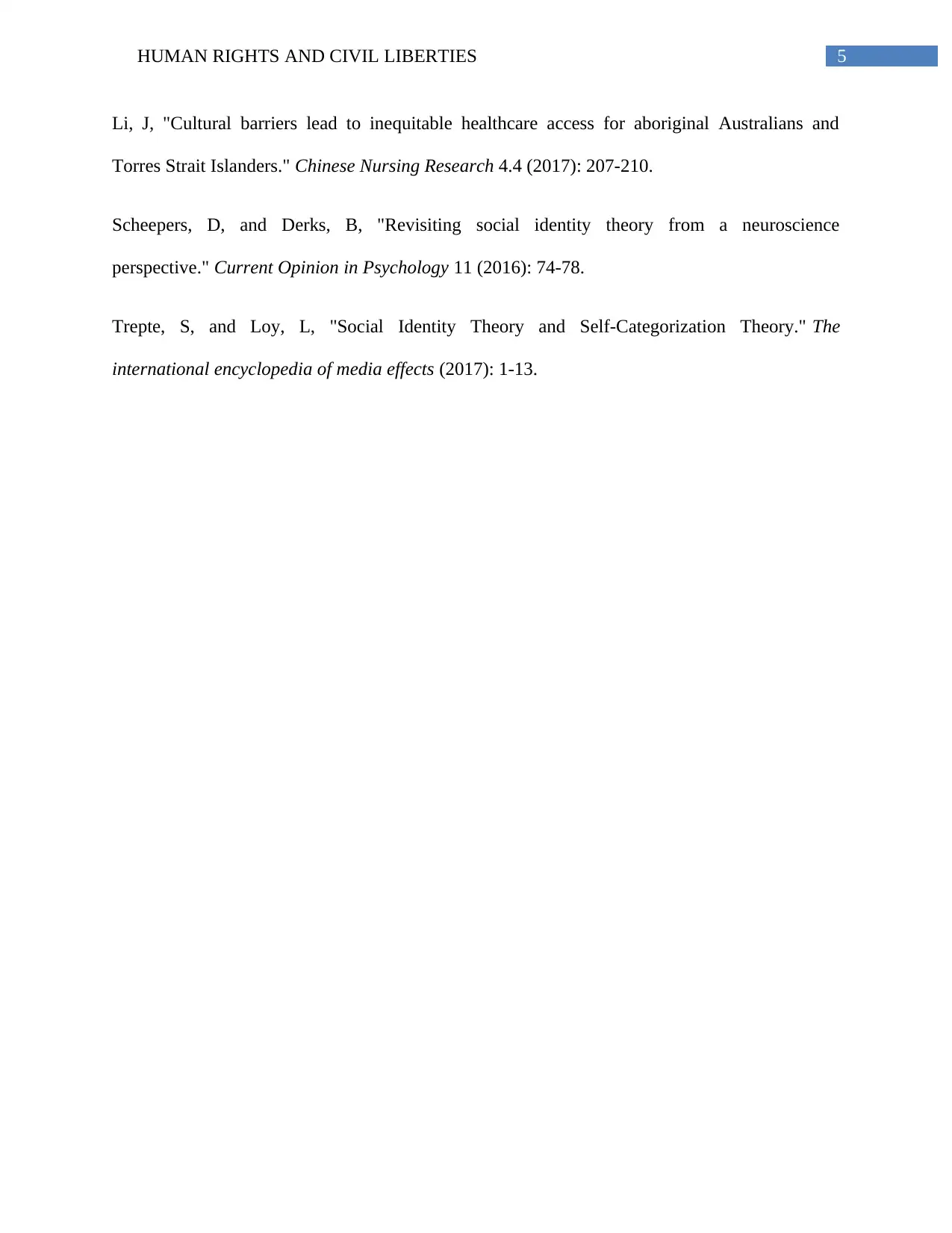
5HUMAN RIGHTS AND CIVIL LIBERTIES
Li, J, "Cultural barriers lead to inequitable healthcare access for aboriginal Australians and
Torres Strait Islanders." Chinese Nursing Research 4.4 (2017): 207-210.
Scheepers, D, and Derks, B, "Revisiting social identity theory from a neuroscience
perspective." Current Opinion in Psychology 11 (2016): 74-78.
Trepte, S, and Loy, L, "Social Identity Theory and Self‐Categorization Theory." The
international encyclopedia of media effects (2017): 1-13.
Li, J, "Cultural barriers lead to inequitable healthcare access for aboriginal Australians and
Torres Strait Islanders." Chinese Nursing Research 4.4 (2017): 207-210.
Scheepers, D, and Derks, B, "Revisiting social identity theory from a neuroscience
perspective." Current Opinion in Psychology 11 (2016): 74-78.
Trepte, S, and Loy, L, "Social Identity Theory and Self‐Categorization Theory." The
international encyclopedia of media effects (2017): 1-13.
⊘ This is a preview!⊘
Do you want full access?
Subscribe today to unlock all pages.

Trusted by 1+ million students worldwide
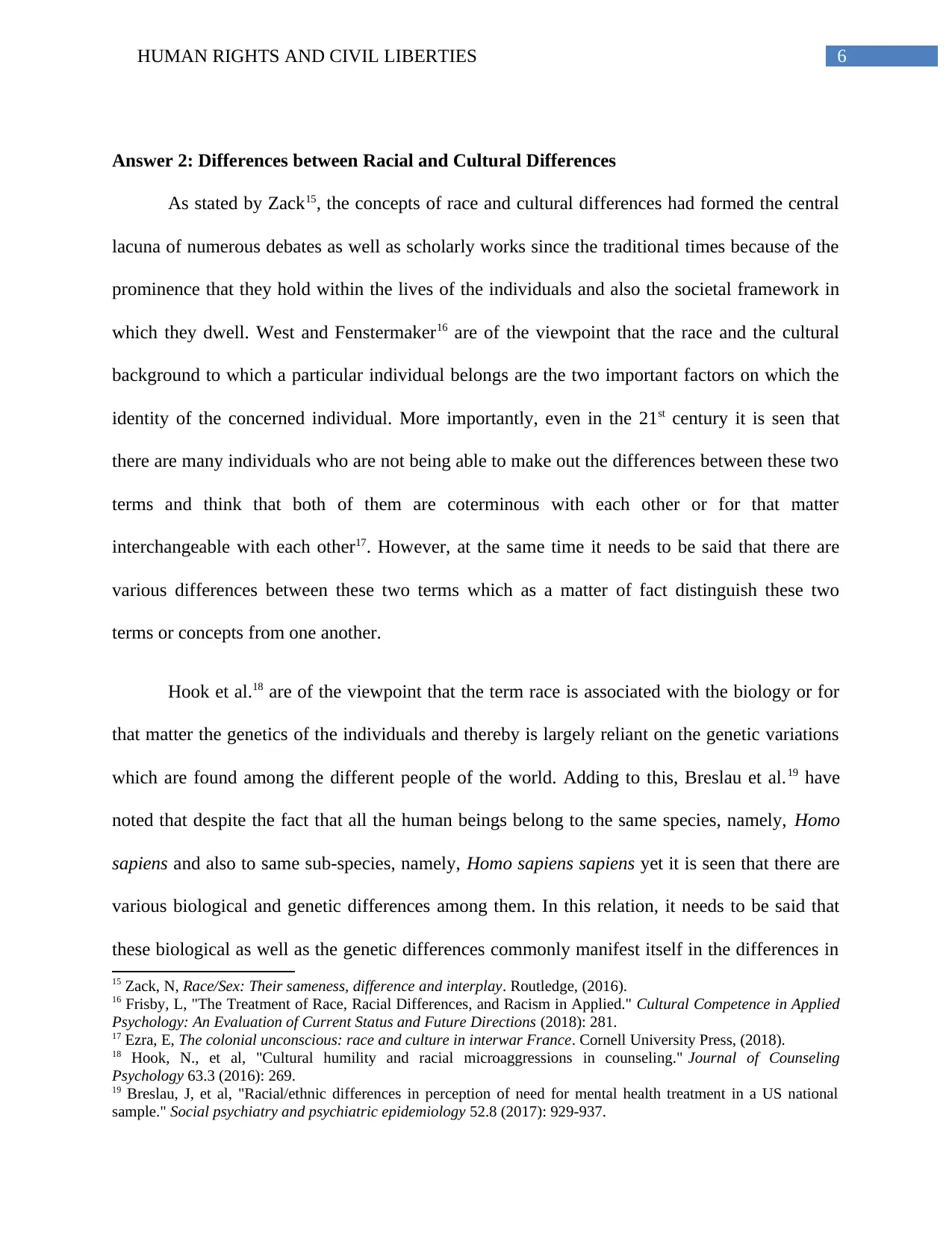
6HUMAN RIGHTS AND CIVIL LIBERTIES
Answer 2: Differences between Racial and Cultural Differences
As stated by Zack15, the concepts of race and cultural differences had formed the central
lacuna of numerous debates as well as scholarly works since the traditional times because of the
prominence that they hold within the lives of the individuals and also the societal framework in
which they dwell. West and Fenstermaker16 are of the viewpoint that the race and the cultural
background to which a particular individual belongs are the two important factors on which the
identity of the concerned individual. More importantly, even in the 21st century it is seen that
there are many individuals who are not being able to make out the differences between these two
terms and think that both of them are coterminous with each other or for that matter
interchangeable with each other17. However, at the same time it needs to be said that there are
various differences between these two terms which as a matter of fact distinguish these two
terms or concepts from one another.
Hook et al.18 are of the viewpoint that the term race is associated with the biology or for
that matter the genetics of the individuals and thereby is largely reliant on the genetic variations
which are found among the different people of the world. Adding to this, Breslau et al.19 have
noted that despite the fact that all the human beings belong to the same species, namely, Homo
sapiens and also to same sub-species, namely, Homo sapiens sapiens yet it is seen that there are
various biological and genetic differences among them. In this relation, it needs to be said that
these biological as well as the genetic differences commonly manifest itself in the differences in
15 Zack, N, Race/Sex: Their sameness, difference and interplay. Routledge, (2016).
16 Frisby, L, "The Treatment of Race, Racial Differences, and Racism in Applied." Cultural Competence in Applied
Psychology: An Evaluation of Current Status and Future Directions (2018): 281.
17 Ezra, E, The colonial unconscious: race and culture in interwar France. Cornell University Press, (2018).
18 Hook, N., et al, "Cultural humility and racial microaggressions in counseling." Journal of Counseling
Psychology 63.3 (2016): 269.
19 Breslau, J, et al, "Racial/ethnic differences in perception of need for mental health treatment in a US national
sample." Social psychiatry and psychiatric epidemiology 52.8 (2017): 929-937.
Answer 2: Differences between Racial and Cultural Differences
As stated by Zack15, the concepts of race and cultural differences had formed the central
lacuna of numerous debates as well as scholarly works since the traditional times because of the
prominence that they hold within the lives of the individuals and also the societal framework in
which they dwell. West and Fenstermaker16 are of the viewpoint that the race and the cultural
background to which a particular individual belongs are the two important factors on which the
identity of the concerned individual. More importantly, even in the 21st century it is seen that
there are many individuals who are not being able to make out the differences between these two
terms and think that both of them are coterminous with each other or for that matter
interchangeable with each other17. However, at the same time it needs to be said that there are
various differences between these two terms which as a matter of fact distinguish these two
terms or concepts from one another.
Hook et al.18 are of the viewpoint that the term race is associated with the biology or for
that matter the genetics of the individuals and thereby is largely reliant on the genetic variations
which are found among the different people of the world. Adding to this, Breslau et al.19 have
noted that despite the fact that all the human beings belong to the same species, namely, Homo
sapiens and also to same sub-species, namely, Homo sapiens sapiens yet it is seen that there are
various biological and genetic differences among them. In this relation, it needs to be said that
these biological as well as the genetic differences commonly manifest itself in the differences in
15 Zack, N, Race/Sex: Their sameness, difference and interplay. Routledge, (2016).
16 Frisby, L, "The Treatment of Race, Racial Differences, and Racism in Applied." Cultural Competence in Applied
Psychology: An Evaluation of Current Status and Future Directions (2018): 281.
17 Ezra, E, The colonial unconscious: race and culture in interwar France. Cornell University Press, (2018).
18 Hook, N., et al, "Cultural humility and racial microaggressions in counseling." Journal of Counseling
Psychology 63.3 (2016): 269.
19 Breslau, J, et al, "Racial/ethnic differences in perception of need for mental health treatment in a US national
sample." Social psychiatry and psychiatric epidemiology 52.8 (2017): 929-937.
Paraphrase This Document
Need a fresh take? Get an instant paraphrase of this document with our AI Paraphraser
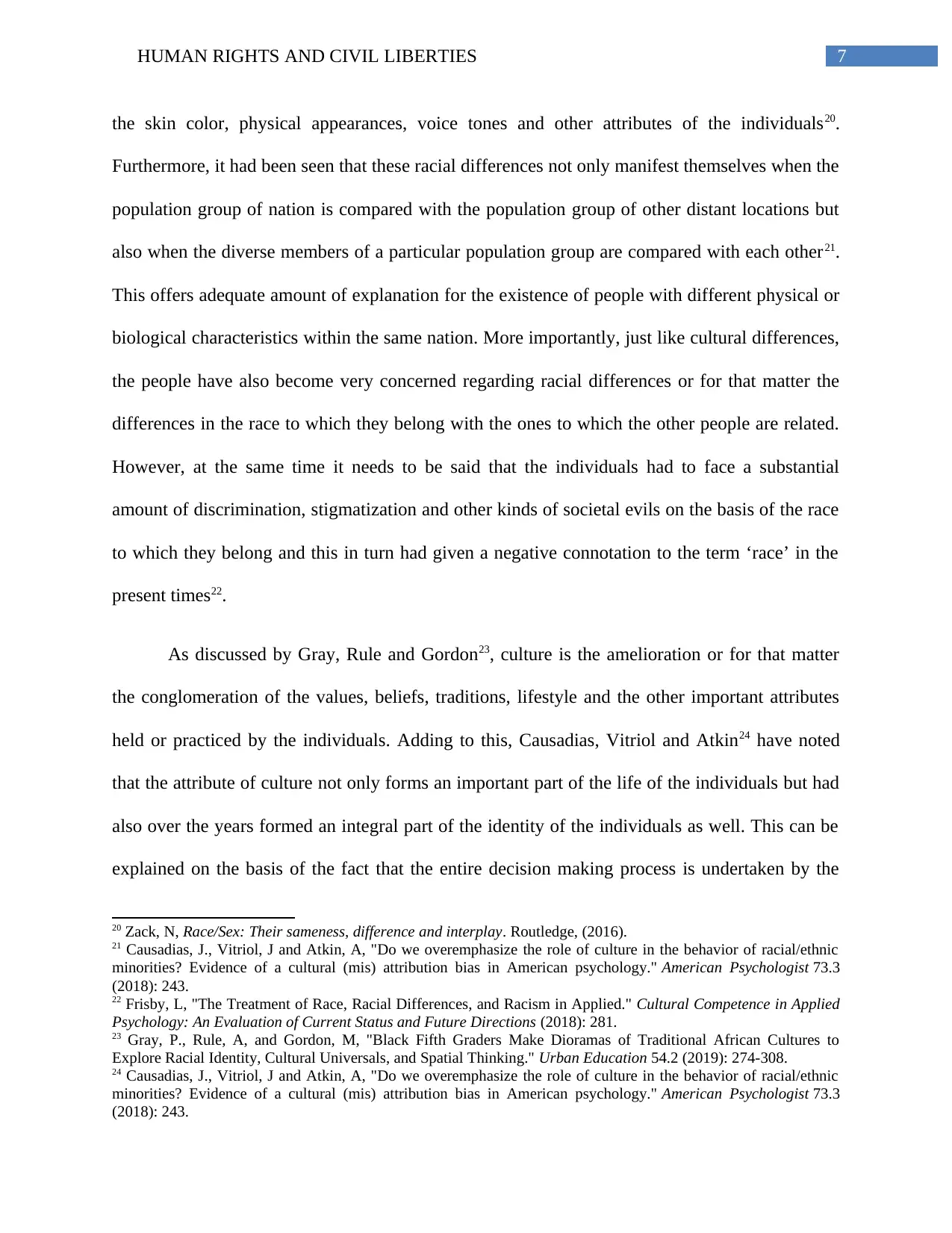
7HUMAN RIGHTS AND CIVIL LIBERTIES
the skin color, physical appearances, voice tones and other attributes of the individuals20.
Furthermore, it had been seen that these racial differences not only manifest themselves when the
population group of nation is compared with the population group of other distant locations but
also when the diverse members of a particular population group are compared with each other21.
This offers adequate amount of explanation for the existence of people with different physical or
biological characteristics within the same nation. More importantly, just like cultural differences,
the people have also become very concerned regarding racial differences or for that matter the
differences in the race to which they belong with the ones to which the other people are related.
However, at the same time it needs to be said that the individuals had to face a substantial
amount of discrimination, stigmatization and other kinds of societal evils on the basis of the race
to which they belong and this in turn had given a negative connotation to the term ‘race’ in the
present times22.
As discussed by Gray, Rule and Gordon23, culture is the amelioration or for that matter
the conglomeration of the values, beliefs, traditions, lifestyle and the other important attributes
held or practiced by the individuals. Adding to this, Causadias, Vitriol and Atkin24 have noted
that the attribute of culture not only forms an important part of the life of the individuals but had
also over the years formed an integral part of the identity of the individuals as well. This can be
explained on the basis of the fact that the entire decision making process is undertaken by the
20 Zack, N, Race/Sex: Their sameness, difference and interplay. Routledge, (2016).
21 Causadias, J., Vitriol, J and Atkin, A, "Do we overemphasize the role of culture in the behavior of racial/ethnic
minorities? Evidence of a cultural (mis) attribution bias in American psychology." American Psychologist 73.3
(2018): 243.
22 Frisby, L, "The Treatment of Race, Racial Differences, and Racism in Applied." Cultural Competence in Applied
Psychology: An Evaluation of Current Status and Future Directions (2018): 281.
23 Gray, P., Rule, A, and Gordon, M, "Black Fifth Graders Make Dioramas of Traditional African Cultures to
Explore Racial Identity, Cultural Universals, and Spatial Thinking." Urban Education 54.2 (2019): 274-308.
24 Causadias, J., Vitriol, J and Atkin, A, "Do we overemphasize the role of culture in the behavior of racial/ethnic
minorities? Evidence of a cultural (mis) attribution bias in American psychology." American Psychologist 73.3
(2018): 243.
the skin color, physical appearances, voice tones and other attributes of the individuals20.
Furthermore, it had been seen that these racial differences not only manifest themselves when the
population group of nation is compared with the population group of other distant locations but
also when the diverse members of a particular population group are compared with each other21.
This offers adequate amount of explanation for the existence of people with different physical or
biological characteristics within the same nation. More importantly, just like cultural differences,
the people have also become very concerned regarding racial differences or for that matter the
differences in the race to which they belong with the ones to which the other people are related.
However, at the same time it needs to be said that the individuals had to face a substantial
amount of discrimination, stigmatization and other kinds of societal evils on the basis of the race
to which they belong and this in turn had given a negative connotation to the term ‘race’ in the
present times22.
As discussed by Gray, Rule and Gordon23, culture is the amelioration or for that matter
the conglomeration of the values, beliefs, traditions, lifestyle and the other important attributes
held or practiced by the individuals. Adding to this, Causadias, Vitriol and Atkin24 have noted
that the attribute of culture not only forms an important part of the life of the individuals but had
also over the years formed an integral part of the identity of the individuals as well. This can be
explained on the basis of the fact that the entire decision making process is undertaken by the
20 Zack, N, Race/Sex: Their sameness, difference and interplay. Routledge, (2016).
21 Causadias, J., Vitriol, J and Atkin, A, "Do we overemphasize the role of culture in the behavior of racial/ethnic
minorities? Evidence of a cultural (mis) attribution bias in American psychology." American Psychologist 73.3
(2018): 243.
22 Frisby, L, "The Treatment of Race, Racial Differences, and Racism in Applied." Cultural Competence in Applied
Psychology: An Evaluation of Current Status and Future Directions (2018): 281.
23 Gray, P., Rule, A, and Gordon, M, "Black Fifth Graders Make Dioramas of Traditional African Cultures to
Explore Racial Identity, Cultural Universals, and Spatial Thinking." Urban Education 54.2 (2019): 274-308.
24 Causadias, J., Vitriol, J and Atkin, A, "Do we overemphasize the role of culture in the behavior of racial/ethnic
minorities? Evidence of a cultural (mis) attribution bias in American psychology." American Psychologist 73.3
(2018): 243.
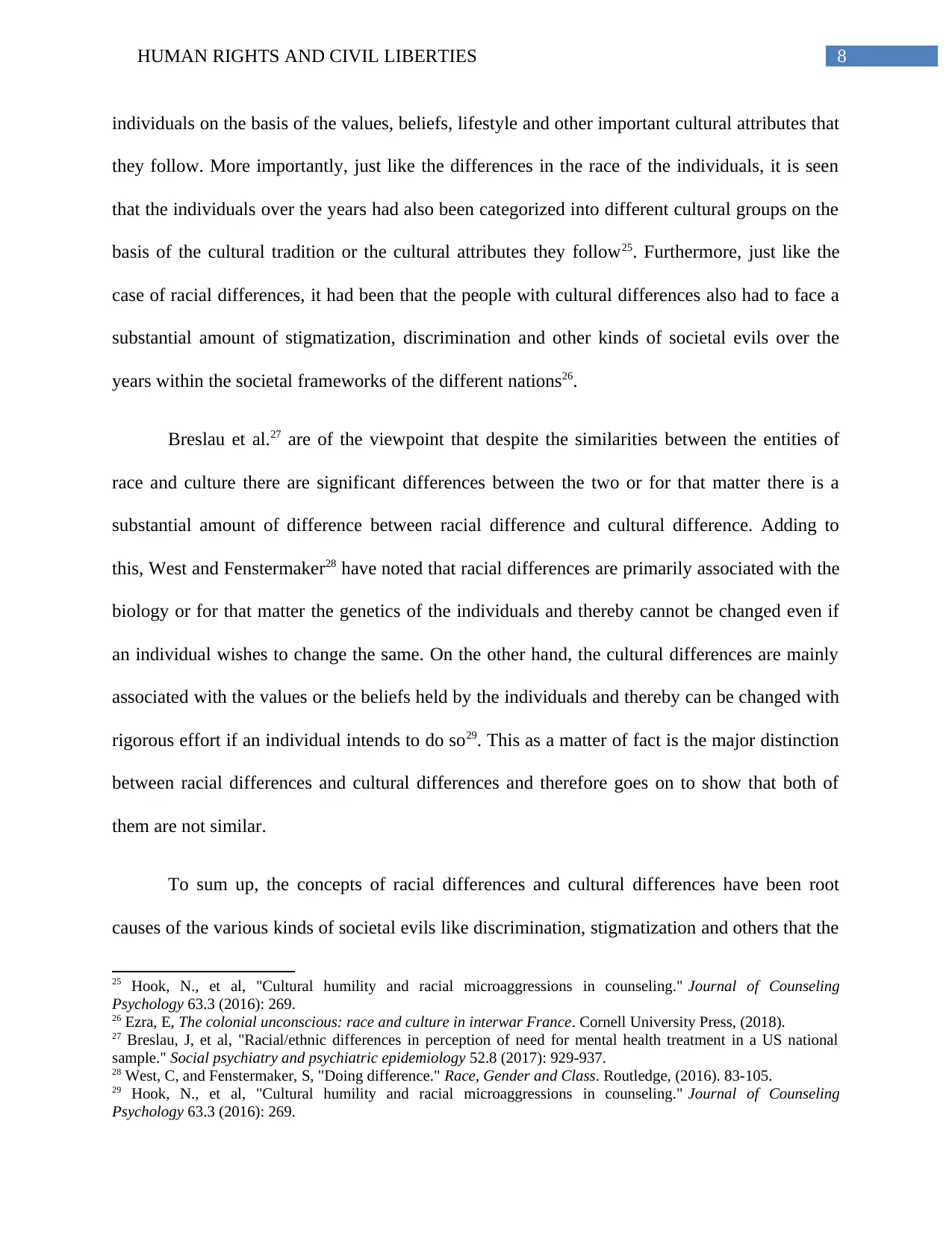
8HUMAN RIGHTS AND CIVIL LIBERTIES
individuals on the basis of the values, beliefs, lifestyle and other important cultural attributes that
they follow. More importantly, just like the differences in the race of the individuals, it is seen
that the individuals over the years had also been categorized into different cultural groups on the
basis of the cultural tradition or the cultural attributes they follow25. Furthermore, just like the
case of racial differences, it had been that the people with cultural differences also had to face a
substantial amount of stigmatization, discrimination and other kinds of societal evils over the
years within the societal frameworks of the different nations26.
Breslau et al.27 are of the viewpoint that despite the similarities between the entities of
race and culture there are significant differences between the two or for that matter there is a
substantial amount of difference between racial difference and cultural difference. Adding to
this, West and Fenstermaker28 have noted that racial differences are primarily associated with the
biology or for that matter the genetics of the individuals and thereby cannot be changed even if
an individual wishes to change the same. On the other hand, the cultural differences are mainly
associated with the values or the beliefs held by the individuals and thereby can be changed with
rigorous effort if an individual intends to do so29. This as a matter of fact is the major distinction
between racial differences and cultural differences and therefore goes on to show that both of
them are not similar.
To sum up, the concepts of racial differences and cultural differences have been root
causes of the various kinds of societal evils like discrimination, stigmatization and others that the
25 Hook, N., et al, "Cultural humility and racial microaggressions in counseling." Journal of Counseling
Psychology 63.3 (2016): 269.
26 Ezra, E, The colonial unconscious: race and culture in interwar France. Cornell University Press, (2018).
27 Breslau, J, et al, "Racial/ethnic differences in perception of need for mental health treatment in a US national
sample." Social psychiatry and psychiatric epidemiology 52.8 (2017): 929-937.
28 West, C, and Fenstermaker, S, "Doing difference." Race, Gender and Class. Routledge, (2016). 83-105.
29 Hook, N., et al, "Cultural humility and racial microaggressions in counseling." Journal of Counseling
Psychology 63.3 (2016): 269.
individuals on the basis of the values, beliefs, lifestyle and other important cultural attributes that
they follow. More importantly, just like the differences in the race of the individuals, it is seen
that the individuals over the years had also been categorized into different cultural groups on the
basis of the cultural tradition or the cultural attributes they follow25. Furthermore, just like the
case of racial differences, it had been that the people with cultural differences also had to face a
substantial amount of stigmatization, discrimination and other kinds of societal evils over the
years within the societal frameworks of the different nations26.
Breslau et al.27 are of the viewpoint that despite the similarities between the entities of
race and culture there are significant differences between the two or for that matter there is a
substantial amount of difference between racial difference and cultural difference. Adding to
this, West and Fenstermaker28 have noted that racial differences are primarily associated with the
biology or for that matter the genetics of the individuals and thereby cannot be changed even if
an individual wishes to change the same. On the other hand, the cultural differences are mainly
associated with the values or the beliefs held by the individuals and thereby can be changed with
rigorous effort if an individual intends to do so29. This as a matter of fact is the major distinction
between racial differences and cultural differences and therefore goes on to show that both of
them are not similar.
To sum up, the concepts of racial differences and cultural differences have been root
causes of the various kinds of societal evils like discrimination, stigmatization and others that the
25 Hook, N., et al, "Cultural humility and racial microaggressions in counseling." Journal of Counseling
Psychology 63.3 (2016): 269.
26 Ezra, E, The colonial unconscious: race and culture in interwar France. Cornell University Press, (2018).
27 Breslau, J, et al, "Racial/ethnic differences in perception of need for mental health treatment in a US national
sample." Social psychiatry and psychiatric epidemiology 52.8 (2017): 929-937.
28 West, C, and Fenstermaker, S, "Doing difference." Race, Gender and Class. Routledge, (2016). 83-105.
29 Hook, N., et al, "Cultural humility and racial microaggressions in counseling." Journal of Counseling
Psychology 63.3 (2016): 269.
⊘ This is a preview!⊘
Do you want full access?
Subscribe today to unlock all pages.

Trusted by 1+ million students worldwide
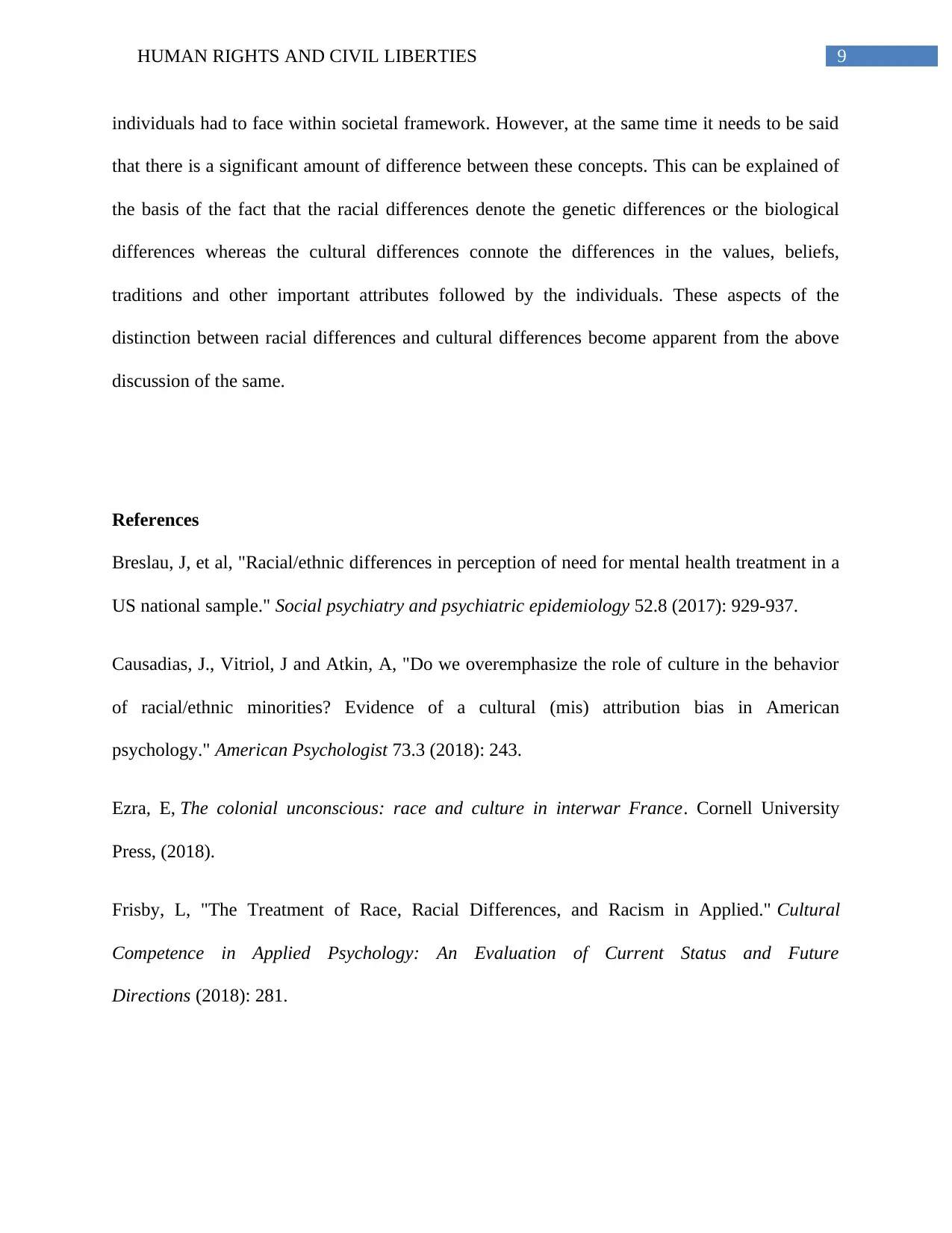
9HUMAN RIGHTS AND CIVIL LIBERTIES
individuals had to face within societal framework. However, at the same time it needs to be said
that there is a significant amount of difference between these concepts. This can be explained of
the basis of the fact that the racial differences denote the genetic differences or the biological
differences whereas the cultural differences connote the differences in the values, beliefs,
traditions and other important attributes followed by the individuals. These aspects of the
distinction between racial differences and cultural differences become apparent from the above
discussion of the same.
References
Breslau, J, et al, "Racial/ethnic differences in perception of need for mental health treatment in a
US national sample." Social psychiatry and psychiatric epidemiology 52.8 (2017): 929-937.
Causadias, J., Vitriol, J and Atkin, A, "Do we overemphasize the role of culture in the behavior
of racial/ethnic minorities? Evidence of a cultural (mis) attribution bias in American
psychology." American Psychologist 73.3 (2018): 243.
Ezra, E, The colonial unconscious: race and culture in interwar France. Cornell University
Press, (2018).
Frisby, L, "The Treatment of Race, Racial Differences, and Racism in Applied." Cultural
Competence in Applied Psychology: An Evaluation of Current Status and Future
Directions (2018): 281.
individuals had to face within societal framework. However, at the same time it needs to be said
that there is a significant amount of difference between these concepts. This can be explained of
the basis of the fact that the racial differences denote the genetic differences or the biological
differences whereas the cultural differences connote the differences in the values, beliefs,
traditions and other important attributes followed by the individuals. These aspects of the
distinction between racial differences and cultural differences become apparent from the above
discussion of the same.
References
Breslau, J, et al, "Racial/ethnic differences in perception of need for mental health treatment in a
US national sample." Social psychiatry and psychiatric epidemiology 52.8 (2017): 929-937.
Causadias, J., Vitriol, J and Atkin, A, "Do we overemphasize the role of culture in the behavior
of racial/ethnic minorities? Evidence of a cultural (mis) attribution bias in American
psychology." American Psychologist 73.3 (2018): 243.
Ezra, E, The colonial unconscious: race and culture in interwar France. Cornell University
Press, (2018).
Frisby, L, "The Treatment of Race, Racial Differences, and Racism in Applied." Cultural
Competence in Applied Psychology: An Evaluation of Current Status and Future
Directions (2018): 281.
Paraphrase This Document
Need a fresh take? Get an instant paraphrase of this document with our AI Paraphraser
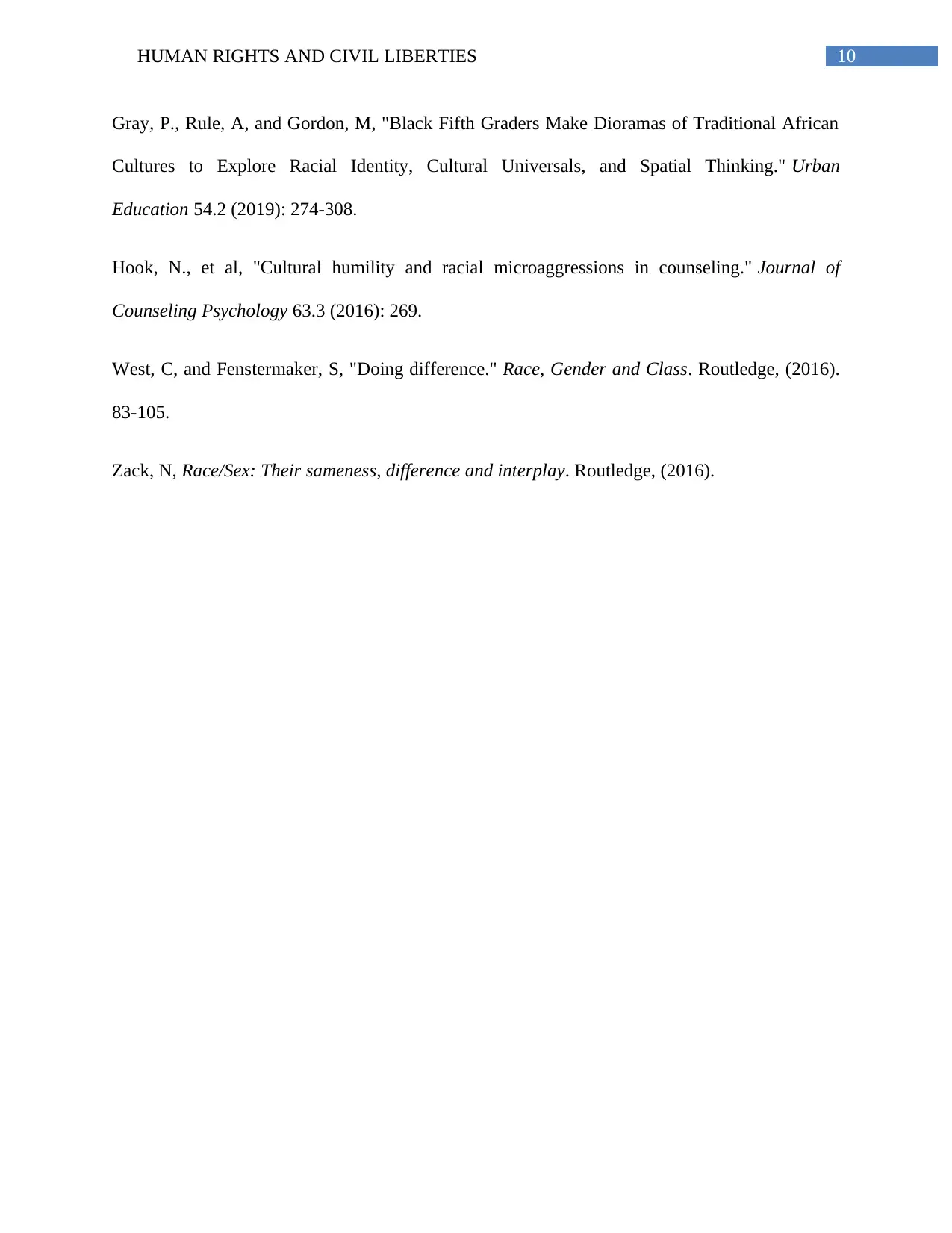
10HUMAN RIGHTS AND CIVIL LIBERTIES
Gray, P., Rule, A, and Gordon, M, "Black Fifth Graders Make Dioramas of Traditional African
Cultures to Explore Racial Identity, Cultural Universals, and Spatial Thinking." Urban
Education 54.2 (2019): 274-308.
Hook, N., et al, "Cultural humility and racial microaggressions in counseling." Journal of
Counseling Psychology 63.3 (2016): 269.
West, C, and Fenstermaker, S, "Doing difference." Race, Gender and Class. Routledge, (2016).
83-105.
Zack, N, Race/Sex: Their sameness, difference and interplay. Routledge, (2016).
Gray, P., Rule, A, and Gordon, M, "Black Fifth Graders Make Dioramas of Traditional African
Cultures to Explore Racial Identity, Cultural Universals, and Spatial Thinking." Urban
Education 54.2 (2019): 274-308.
Hook, N., et al, "Cultural humility and racial microaggressions in counseling." Journal of
Counseling Psychology 63.3 (2016): 269.
West, C, and Fenstermaker, S, "Doing difference." Race, Gender and Class. Routledge, (2016).
83-105.
Zack, N, Race/Sex: Their sameness, difference and interplay. Routledge, (2016).
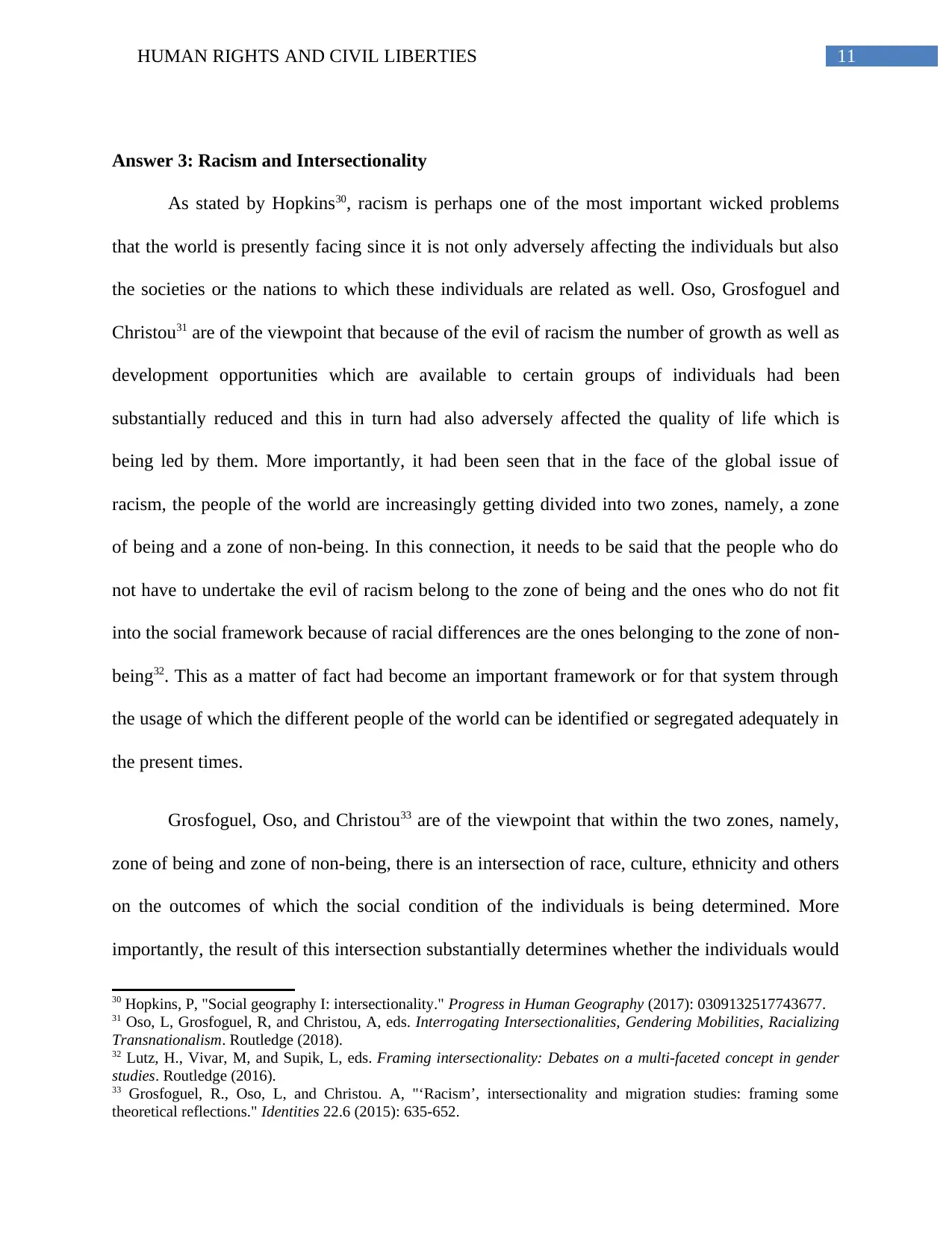
11HUMAN RIGHTS AND CIVIL LIBERTIES
Answer 3: Racism and Intersectionality
As stated by Hopkins30, racism is perhaps one of the most important wicked problems
that the world is presently facing since it is not only adversely affecting the individuals but also
the societies or the nations to which these individuals are related as well. Oso, Grosfoguel and
Christou31 are of the viewpoint that because of the evil of racism the number of growth as well as
development opportunities which are available to certain groups of individuals had been
substantially reduced and this in turn had also adversely affected the quality of life which is
being led by them. More importantly, it had been seen that in the face of the global issue of
racism, the people of the world are increasingly getting divided into two zones, namely, a zone
of being and a zone of non-being. In this connection, it needs to be said that the people who do
not have to undertake the evil of racism belong to the zone of being and the ones who do not fit
into the social framework because of racial differences are the ones belonging to the zone of non-
being32. This as a matter of fact had become an important framework or for that system through
the usage of which the different people of the world can be identified or segregated adequately in
the present times.
Grosfoguel, Oso, and Christou33 are of the viewpoint that within the two zones, namely,
zone of being and zone of non-being, there is an intersection of race, culture, ethnicity and others
on the outcomes of which the social condition of the individuals is being determined. More
importantly, the result of this intersection substantially determines whether the individuals would
30 Hopkins, P, "Social geography I: intersectionality." Progress in Human Geography (2017): 0309132517743677.
31 Oso, L, Grosfoguel, R, and Christou, A, eds. Interrogating Intersectionalities, Gendering Mobilities, Racializing
Transnationalism. Routledge (2018).
32 Lutz, H., Vivar, M, and Supik, L, eds. Framing intersectionality: Debates on a multi-faceted concept in gender
studies. Routledge (2016).
33 Grosfoguel, R., Oso, L, and Christou. A, "‘Racism’, intersectionality and migration studies: framing some
theoretical reflections." Identities 22.6 (2015): 635-652.
Answer 3: Racism and Intersectionality
As stated by Hopkins30, racism is perhaps one of the most important wicked problems
that the world is presently facing since it is not only adversely affecting the individuals but also
the societies or the nations to which these individuals are related as well. Oso, Grosfoguel and
Christou31 are of the viewpoint that because of the evil of racism the number of growth as well as
development opportunities which are available to certain groups of individuals had been
substantially reduced and this in turn had also adversely affected the quality of life which is
being led by them. More importantly, it had been seen that in the face of the global issue of
racism, the people of the world are increasingly getting divided into two zones, namely, a zone
of being and a zone of non-being. In this connection, it needs to be said that the people who do
not have to undertake the evil of racism belong to the zone of being and the ones who do not fit
into the social framework because of racial differences are the ones belonging to the zone of non-
being32. This as a matter of fact had become an important framework or for that system through
the usage of which the different people of the world can be identified or segregated adequately in
the present times.
Grosfoguel, Oso, and Christou33 are of the viewpoint that within the two zones, namely,
zone of being and zone of non-being, there is an intersection of race, culture, ethnicity and others
on the outcomes of which the social condition of the individuals is being determined. More
importantly, the result of this intersection substantially determines whether the individuals would
30 Hopkins, P, "Social geography I: intersectionality." Progress in Human Geography (2017): 0309132517743677.
31 Oso, L, Grosfoguel, R, and Christou, A, eds. Interrogating Intersectionalities, Gendering Mobilities, Racializing
Transnationalism. Routledge (2018).
32 Lutz, H., Vivar, M, and Supik, L, eds. Framing intersectionality: Debates on a multi-faceted concept in gender
studies. Routledge (2016).
33 Grosfoguel, R., Oso, L, and Christou. A, "‘Racism’, intersectionality and migration studies: framing some
theoretical reflections." Identities 22.6 (2015): 635-652.
⊘ This is a preview!⊘
Do you want full access?
Subscribe today to unlock all pages.

Trusted by 1+ million students worldwide
1 out of 16
Related Documents
Your All-in-One AI-Powered Toolkit for Academic Success.
+13062052269
info@desklib.com
Available 24*7 on WhatsApp / Email
![[object Object]](/_next/static/media/star-bottom.7253800d.svg)
Unlock your academic potential
Copyright © 2020–2025 A2Z Services. All Rights Reserved. Developed and managed by ZUCOL.





